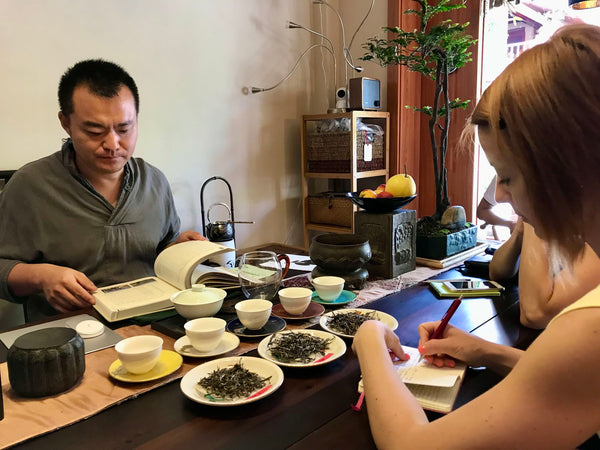Types of tea
Types of Tea – A Guide to World Tea
The world of tea drinking may seem endless at first glance: shapes, flavors, aromas, colors – as many experiences as there are teas. Yet there is an order that helps you navigate: this is the grouping of teas according to processing. In this post, we will introduce the six main types of tea, their origin, processing, flavors and practical features.
White tea – 白茶Bai cha
White tea is the type of tea made with the least human intervention. The leaves are left to wither after being picked, then dried and sorted. Mild oxidation occurs during natural drying. The best-known region is Fujian (Fuding, Zhenghe), but white tea is also made in Yunnan, and even in India and Nepal.
The most well-known versions are:
- Yin Zhen (Silver Needles): made exclusively from fluffy buds, it has an extremely delicate, elegant flavor.
- Bai Mu Dan (White Peony): bud + leaf combination, with a slightly more powerful, fruity character.
- Gong Mei and Shou Mei: mainly composed of leaves, with riper, earthier notes.
Interesting fact: some Shou Mei teas may also contain buds, so the categories are not always rigid.
Yellow tea - 黄茶Huang cha
A rare and special tea, the processing of which begins similarly to that of green tea, but includes an extra step: the leaves are piled up, covered with cloth and lightly fermented (men huang). This smooths out the harsh flavors of green tea and brings back the softness typical of white teas. Its taste is a mix of freshness and deep sweet tones. For a long time, it was only present in Chinese culture as a gift tea.
Green tea - 绿茶Lü cha
The most popular type of tea. The leaves are kept free from oxidation by heat treatment (steaming or roasting) after a short withering period. This can happen:
- By drying in the sun – slightly oxidized effect,
- By steaming – common in Japan, e.g. Sencha, Matcha,
- Baked with hot air – softer, vegetal flavors,
- Fried in a wok – classic Chinese style like Long Jing, Bi Luo Chun.
Processing the raw material quickly and gently is key. Green teas from the spring harvest are usually the best. Good green tea is not bitter – the unpleasant taste is either due to weak raw materials or water at the wrong temperature.
Oolong tea - 乌龙茶Wulong cha
Oolongs are a broad group of partially oxidized teas (20–85% oxidation). Their preparation is complex and long: withering, shaking, rolling, resting, roasting - even overnight. The leaves are usually picked at a more developed stage, sometimes with the stems.
According to their form, they can be:
- Rolled into a ball: e.g. Tie Guan Yin, Taiwanese High Mountain oolongs,
- Elongated, twisted: e.g. Wuyi yancha, Dancong.
Their flavors are extremely diverse: from floral, creamy styles to mineral, roasted characters. Their caffeine content is moderate, so they are also great to drink in the afternoon.
Red tea – 红茶Hong cha (In the West: black tea)
A fully oxidized tea with a full, rich aroma. During processing, the leaves are withered, rolled, and oxidized for a longer period of time. Final drying can be done in air or over a fire. Classic examples include Qimen, Dian Hong, Jin Jun Mei, and Lapsang Souchong.
Teas can be made from buds (elegant, sweet flavors) or more developed leaves (malty, cocoa notes). The caffeine is absorbed quickly, making it an ideal choice for an energizing morning tea.
Dark tea - 黑茶Hei cha
Post-ripened, fermented teas that are transformed with the help of microorganisms. The best known representative is Puerh from Yunnan, which can be:
- Sheng (raw): matures slowly over years, has a complex flavor,
- Shu (aged): made with rapid fermentation, has an earthy, velvety character.
Other well-known dark teas include Liu Bao (Guangxi), Liu An (Anhui), and Hei Cha from Hunan. During their production, the tea is piled up, kept moist, turned over several times, and microbiological fermentation transforms the chemical structure of the leaves. The result is a tea that is gentle on the stomach, rich in minerals, and has a deep flavor. Some old, rare specimens change hands as real treasures.
Tea is not just a drink – it is culture, ceremony, meditation, and travel in a single cup.
If you are curious about how to best prepare these teas, check out our tea brewing guides or visit us in person at the Teavolution Tea Shop in Budapest!
With love:
The Teavolution team



